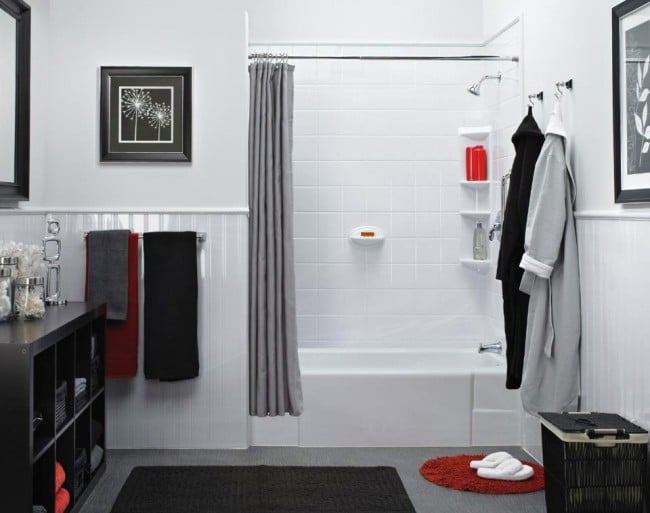5 Points Nobody Tells You around Shower & Tub Wall Surface Panels
5 Points Nobody Tells You around Shower & Tub Wall Surface Panels
Blog Article
{This Site We've come across this post relating to Hiring a Plumbing Company below on the net and concluded it made good sense to discuss it with you on this site. We recommend that you clean your acrylic bathing product made of Delta ProCrylic or Acrylic with Innovex Technology with non-abrasive soaps and cleaners, such as: When it’s time to clean, always use a terry cloth towel, soft cloth or sponge to avoid scratching the acrylic surface. Don’t use abrasive scrubbing pads, steel wool or sponges, cause permanent damage to the acrylic material. If you use a drain cleaner or clog remover, be sure to rinse thoroughly with water so no product is left standing near the drain. Some chemicals and cleaners may deteriorate acrylic surfaces, causing cracks and, potentially, property damage. To avoid this, don’t use cleaning products that state on their label that they are not suitable for use on Acrylic, ABS, Polystyrene or Plastic. Be sure to check the label of any product before you apply it to the surface; it’s easier to avoid damage than to try to remedy it. Chemicals we do not recommend using to clean acrylic showers/tubs: When you’re ready to apply sealant, a little planning goes a long way. Pick up some painter’s tape and use it to mask off the seam to help make cleaning up easier. When you’re applying the bead, use a constant, steady speed to avoid an uneven finish. Use a caulk tool or a plastic spoon to work the sealant into the joint. Wetting the tool with denatured alcohol will help create a smooth finish. Follow the directions on the back of the tube for cure time. Certain chemicals and cleaners may deteriorate acrylic surfaces, causing cracks and, potentially, property damage. After you’re finished applying it, clean up the product surface and remove any excess sealant with denatured alcohol. Don’t use solvents (turpentine, lacquer thinner, mineral spirits, paint thinner, MEK, xylene, acetone, naphtha, etc.) that can wreak havoc on an acrylic surface. With a little care and consideration, you can prevent damage to your acrylic shower or tub. Keep a supply of soft cloths handy and remove any damaging products or abrasive scrubbing items from the bathroom to ensure they aren’t around when it’s time to clean. https://www.deltafaucet.com/design-innovation/inspiredliving/how-to-clean-acrylic-shower I'm very drawn to Hiring a Plumbing Company and I hope you appreciated the new blog entry. Sharing is nice. Helping people is fun. I appreciate reading our article about 6 Things to Know About When Hiring a Plumbing Services.
Acrylic bathrooms, shower trays, and other acrylic bathroom ware have actually ended up being more typical in restrooms in recent times. Not as stylish and also sturdy as enamel as well as porcelain bathrooms and also components, they are more affordable and also offer pretty much the very same standard function. Some typical examples of damages to acrylic restroom components include discoloration, cracks, openings, and so on.Bathroom Staining
With long term usage of acrylic bathrooms comes staining or discoloration. While some discolorations can be gotten rid of easily, using special chemicals, others require that the bathroom be resprayed. Aromatherapy oils loosen up the dirt in some cases consequently bring back the bath to its former glory.Chemical Reactions
Occasionally, individuals attempt to repaint the whole surface of their acrylic bathroom by themselves either due to the fact that they do not like the shade to conceal blemishes. You need to never ever use paint remover on acrylic bathrooms. Paint cleaners do not react with the surface area of steel baths, they damage acrylic baths irreversibly.Damaged shower or bathroom surface
Polymer bathroom components are not abrasion-resistant like enamel varieties. Being a really soft material, acrylic scrapes can also be concealed without coating or filling. For these, you need to seek specialist aid for your bath repair services.Cracked Polymer Baths
The life-span of acrylic as well as fiberglass baths is up to 15-20 years for shower frying pans and bathrooms, usually. Splits in an acrylic shower tray are most likely amongst the simplest problems to fix for a repair professional. This is the exact same for PVC, material, as well as other such materials.
Acrylic baths, shower trays, and various other acrylic washroom ware have actually come to be a lot more usual in washrooms in current times. With long term usage of acrylic baths comes discoloration or staining. You need to never make use of paint remover on acrylic bathrooms. Paint eliminators do not respond with the surface of steel baths, they destroy acrylic bathrooms irreversibly. The lifespan of acrylic as well as fiberglass bathrooms is up to 15-20 years for shower pans as well as bathrooms, typically.How to clean Acrylic shower
USE THESE NON-ABRASIVE CLEANERS
DO NOT USE THESE CLEANERS
Sealant Application Tips

Rates